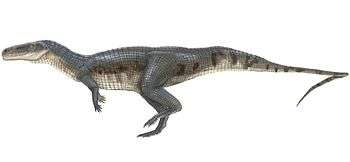Fasolasuchus
| Fasolasuchus Temporal range: Late Triassic, 217–215 Ma | |
|---|---|
 | |
| Lessemsaurus (largest) and Fasolasuchus in Singapore | |
| Scientific classification | |
| Kingdom: | Animalia |
| Phylum: | Chordata |
| Class: | Reptilia |
| Clade: | Loricata |
| Genus: | †Fasolasuchus Bonaparte, 1981 |
| Type species | |
| Fasolasuchus tenax Bonaparte, 1981 | |
Fasolasuchus is an extinct genus of rauisuchid. Fossils have been found from Argentina that date back to the Rhaetian stage of the Late Triassic, making it one of the last rauisuchians to have existed before the order became extinct at the end of the Triassic.[1][2]
Description

It is quite possibly the largest known member of Rauisuchia, with an estimated length of 8–10 meters (26–33 ft), even bigger than the prestosuchid Saurosuchus at 7 meters (23 ft) in length. This would make Fasolasuchus the largest terrestrial predator to have ever existed save for large theropods. Like Saurosuchus, it had only a single row of caudal osteoderms, unusual among rauisuchians.[3] It also had a hyposphene-hypantrum articulation that gave the vertebral column extra rigidity. This feature is also seen in several other rauisuchians such as Postosuchus as well as saurischian dinosaurs.[4][5]
Phylogeny
Cladogram after the analysis of Nesbitt (2011):[6]
| Paracrocodylomorpha |
| ||||||||||||||||||||||||||||||||||||
| |
References
- ↑ Bonaparte, J. F. 1981. Description de “Fasolasuchus tenax” y su significado en la sistemarica y evolucion de los thecodontia. Revista del Museo Argentino de Ciencias Naturales “Bernardino Rivadavia” 3:55–101.
- ↑ Bonaparte, J. F. (1986). Locomotion in Rauisuchid Thecodonts. Journal of Vertebrate Paleontology 3(4):210-218.
- ↑ Sulej, T. (2005). A new rauisuchian reptile (Diapsida: Archosauria) from the Late Triassic of Poland. Journal of Vertebrate Paleontology 25(1):78–86.
- ↑ Weinbaum, J. C. and Hungerbüler, A. (2007). A revision of Poposaurus gracilis (Archosauria: Suchia) based on two new specimens from the Late Triassic of the southwestern U.S.A. Paläontologische Zeitschrift 81(2):131-145.
- ↑ Apesteguia, S. (2005). Evolution of the hyposphene-hypantrum complex within Sauropoda. In: Virginia Tidwell, Kenneth Carpenter, eds., Thunder-lizards: the Sauropodomorph dinosaurs. Bloomington. Indiana University Press. pp. 248-267.
- ↑ Nesbitt, S. J. (2011). "The early evolution of archosaurs: relationships and the origin of major clades" (PDF). Bulletin of the American Museum of Natural History. 352: 1–292. doi:10.1206/352.1.



